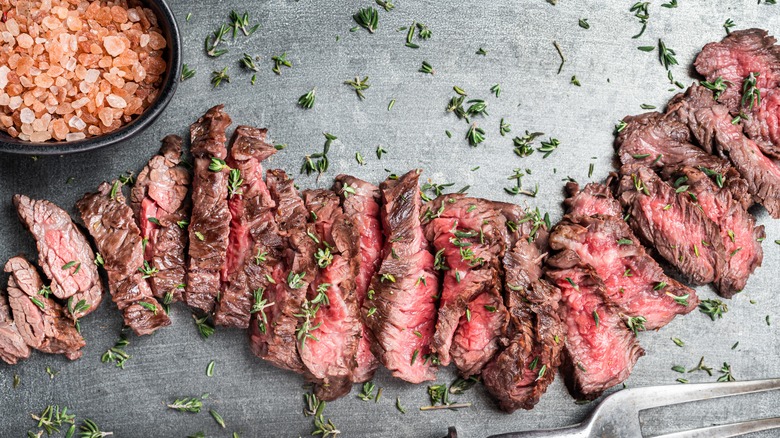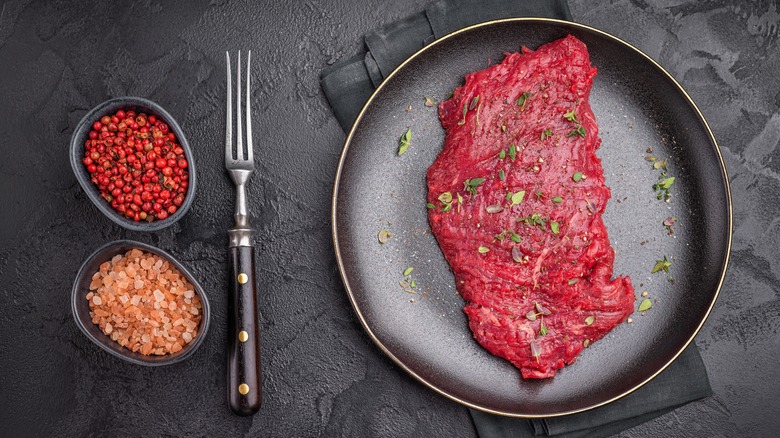Flap Meat Vs Skirt Steak: What's The Difference?
When it comes to steak, finding the right cut for your needs can feel like searching for a needle in a hay steak if you aren't well versed in how cuts differ. Filet mignon might be what you're used to eating at a steakhouse, but it isn't necessarily the best choice for your stir fry. Instead, opt for a thinner steak like flap meat or skirt steak — two cuts that are often confused. So, what sets these steaks apart and how should you use them? Well, we spoke with Dennis Littley, chef and recipe expert at Ask Chef Dennis, to get the sizzle on these steaks.
It all comes down to knowing the in's and out's of your steaks. "For flap meat versus skirt steak," Littley told Food Republic. "They do get confused a lot, but they're not the same." They come from different parts of the cow, which gives them each a different texture, which in turn makes them better suited for different cooking techniques.
Flap meat is slightly denser than skirt steak, so it's better suited toward sauce-forward dishes and slower cooking methods. As long as you're conscious of the most notable qualities of these steaks, you'll be grilling them like a pro in no time. As Littley says, "They're both versatile, but understanding the cut helps you make the most of them." Plus, once you've familiarized with these budget-friendly cuts, you'll know which to avoid in the future.
What is flap meat?
Perhaps the lesser known cut of steak between the two, flap meat can be compared to the more common flank steak because they both come from the same part of the cow. "Flap meat comes from the bottom sirloin," Littley said. In other words, it's a thin slice of the abdominal muscle. "Flap meat is a bit thicker and more uneven," he continued. "But it's tender and takes on marinades beautifully."
Known for its tenderness, flap steak comes in larger portions than skirt steak even though prices are around the same for both because it's not as common. Despite its relative obscurity, this particular cut ranks high among butchers. In fact, flap steak is considered one of the most underrated steaks according to grill masters.
So, why use flap steak? As Chef Dennis notes, this particular cut is ideal for dishes that have a bit more sauce. While skirt steak might be an okay choice in some cases, "Flap meat... is my pick for marinating and slicing into stir fries or rice bowls, where it can soak up flavor and still stay juicy." Not only will you have tender slices of protein to add to your bowl, the steak will integrate well into the dish instead of feeling like you just slapped it on top. Just remember to tenderize your meat ahead of time to loosen those tougher muscle fibers.
What is skirt steak?
Of these two meats, skirt steak is likely the more familiar. It's a versatile cut that does well in high heat. "Skirt steak comes from the plate (underside) of the cow," Littley explained — more specifically, the diaphragm area. When compared to flap meat, "Skirt steak is thinner and has more pronounced muscle striations." Muscle striations are great for bringing out the juiciness of the meat (so long as you know how to cut skirt steak correctly). By cutting against the grain, you separate those muscle fibers which makes for more tender bites.
When preparing skirt steak, keep its texture in mind since this will give you the best cooking results. "I'll go with skirt steak when I want a fast, high-heat sear and bold texture," Littley said. "It's great for grilling or pan searing." You'll keep that juicy inner texture but also get a crispy outer layer you can't achieve as easily using a marinated flap steak. You'll want to use skirt steak for those recipes that "deliver that chewy, flavorful bite you want in fajitas or tacos." Of course, you can still add sauce to your skirt steak. But when grilling, cook it without marinade to let its tenderness shine on its own.



